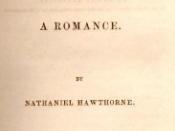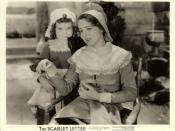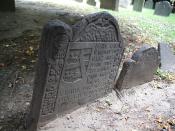Everyone in life has judged someone at one point or another. Even though judgments may be wrong, they are still made by all humans. The community of Boston judges Hester Prynne, a major character in Nathaniel Hawthorne's The Scarlet Letter, about her crime of Adultery. Hester, an attractive and young woman, has committed a horrible crime according to Puritan society. Hester must face being judged due to the scarlet A that she is forced to wear by the community of Boston. Everyone sees the letter and knows what she has done, which makes life for her hard. Hester must also face the anguish that her partner in sin, Arthur Dimmesdale, has to bear with. Roger Chillingworth, Hester's husband, is torturing Reverend Dimmesdale for his evolvement in the mortal sin. In the light of all this, Hester must also be judged by her only daughter Pearl, the outcome of this crime of passion.
The Puritans judge on whether she can still be a good person or not. Hester's punishment, her spiritual and moral growth, and her inability to escape her sin, are the building blocks upon which she is judged for.
Hester's first struggle is the punishment she must face in the beginning of the novel. Even though the punishment for adultery could be death, Hester receives the lighter sentence for which she must spend some time in jail, and stand for three hours upon a scaffold so that she may be publicly purified. Her final and permanent punishment is that she must wear a scarlet A on her breast if she is to remain living in Boston. Hester' must stand on the scaffold with Pearl, a living representation of her sin. Hester does not care much for what the Puritan's think of her, and she does not regret her sin. Hester was given an opportunity to be allowed to make the A herself. Instead of creating a small letter, she makes the letter "so fantastically embroidered and illuminated on her bosom"ÃÂ(Hawthorne 49). The idea behind her making the letter so large is that she does not mind the sin, and she does not feel guilty about it at all. As the women in the market place crowd suggest, Hester's reasoning for making the letter like she did was to "laugh in the faces of [their] godly magistrates, to make a pride out of what they worthy gentlemen meant for her punishment"æ"ÃÂ(49-50). Hester's unacceptance of Puritan views leads her to instead of hiding her shame, let it radiate in the A.
Hester's spiritual and moral growth is highly associated with the way she dealt with her punishment. Because she took pride in her sin, her moral and spiritual growth grew more and more away from what the Puritan's wanted it to do. If Hester took her punishment like the Puritan's wanted, she would feel shame for what she did but she does not. Hester grow by helping people and being true to herself and Pearl. Pearl is one of the reasons why Hester grows as she does. Pearl keeps reminding her mother about the letter and about how Reverend Dimmesdale keeps his hand over his heart all the time. Even though Hester grows, she does not necessarily grow in the Puritan outlook. To Hester, "The scarlet letter had not done its office"ÃÂ(160). The scarlet letter had faulted in making Hester a better Puritan, which is what the society of Boston wanted it to do. Putting the scarlet letter on Hester proved to be an almost pointless punishment since it did not fulfill what the Puritans hoped it would do. In fact the scarlet letter had made Hester look down on the views of the Puritans more than she had before. What she saw was a society of hypocrites that were all afraid to confess their sins. Even though Hester grew morally and spiritually, she did not grow for Boston or grow to make the Puritan's happy: she grew for herself.
Even though Hester accepts her punishment and grows spiritually for her own happiness, she is unable to escape her sin. Hester's struggle to achieve happiness is hindered by Roger Chillingworth, Arthur Dimmesdale, and Pearl. Roger Chillingworth's constant torture of Dimmesdale does not allow Hester to be able to run away with the man she loves. Dimmesdale's hypocrisy and inability to confess his sin leaves Hester all alone to take care of Pearl and does not let her live her life like a normal human being. Pearl's constant references to the letter and to Dimmesdale's heart make her mother look back and don't allow her to be like she was before all this happened. After Hester transfigured in the forest, a "long, deep sigh, in which the burden of shame and anguish departed from her spirit"ÃÂ(200). Hester was finally free, she was free of her sin, but not for long. Pearl refused to go to her mother until she put the scarlet letter back on. Pearl has played a big part in not allowing her mother to escape her sin. Even at the end, when Pearl is a grown woman and Hester is alone, she still has not fully escaped her sin. She went back to Boston and lived there counseling women, never again taking off the scarlet letter. Hester even in death does not escape sin, as on her tombstone "the letter A, gules"ÃÂ(261).
Hester's frailty and vulnerability occur because of her punishment, the way she grows after her punishment, and the fact that she cannot escape her punishment. Because Hester does not accept the Puritan views after her growth, she cannot escape her sin and once again live a normal life. If she gave up her beliefs, then she would be allowed to live normally in the society, but at the cost of her love. If you do what they want you to do, you give up your beliefs, and you give up the effect that your cause has. Hester stays true to herself and does not allow the Puritan's to get to her mind. She doe not believe in Puritan society, and even at the end she does not repent her sin for the Puritan society, but for herself: for her own peace.





